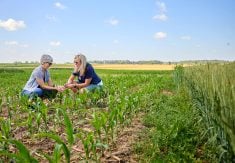Bee deaths associated with antibiotic withdrawal could lead to increased costs in Canadian agriculture, according to recent research from the University of Guelph.
The study is the first large-scale project to assess antibiotic usage trends and their impact on honey bee health in Canada, using data from over 700,000 colonies between 2015 and 2023. The study found that antibiotic restrictions in Canadian beekeeping are correlated with increased bee mortality.
Why it matters: Bee mortality means costs of pollination will be passed on to producers and increase food prices.
Read Also

How stories promote farm safety
Speakers at CASA online conference explain how personal stories can be more valuable than statistics in communicating importance of farm safety
In 2018, regulations put in place the World Health Organization (WHO) and adopted by Canadian agencies restricted the sale of over-the-counter antibiotics in an effort to combat increasing antibiotic resistance.
“The changes put forth weren’t just targeting the honeybee industry or the beekeepers,” said Brendan Daisley, study lead and a postdoctoral researcher with the Department of Molecular and Cellular Biology. “This was just kind of a general push to reduce antibiotic usage in human medical settings as well as agriculture.”
Daisley said the majority of antibiotic applications are in agriculture, not on humans. He said from the point of view of fighting resistance, decreasing the use of antibiotics in agriculture could be a positive.
“They’re necessary from a point of production and yield, but they’re not functionally needed to fight disease (in) a lot of instances.”
For bees, though, those antibiotics are much more crucial.
“They’re needed to treat infectious diseases in honeybees,” said Daisley. “They’re used prophylactically, to prevent diseases, rather than to treat diseases in most cases. So that’s why they’re kind of viewed as not always necessary, because you don’t really know if the infection is there.”
The problem, Daisley said, is there are no viable alternatives currently on the market.
“Going cold turkey, off antibiotics has meant infectious disease has likely ramped up and is responsible for the mortality.”
Daisley said after the rules came into effect in 2018, the use of antibiotics by Canadian beekeepers was cut in half. In that same time, bee mortality doubled.
He clarified beekeepers are not necessarily restricted from buying antibiotics, though it may have become more difficult for them.
“The thought behind that was to ensure that the antibiotics are using are being used appropriately,” he said. Beekeepers used to be able to go to the local farm store and pick up, oxytetracycline, for example, to treat their colonies prophylactically, he said. Now, they need to develop a relationship with a veterinarian and get prescribed antibiotics, just like humans get prescribed antibiotics from their doctor.
Steve Moore, president of the Ontario Beekeepers’ Association said he personally did not have trouble developing a relationship with a veterinarian, but the process can be a turn-off for many producers.
“Any time you introduce an extra step, you’re going to lose a few people just from the convenience factor.”
Moore said smaller beekeeping operations may choose not to bother with the step.
“Maybe they don’t really see the value as much or their livelihoods don’t necessarily depend on it.”
He said this was the main adjustment he had to make around the time of the 2018 regulations, though he supports the process of ensuring antibiotics are used more responsibly.
These problems may well translate into the broader agriculture sector. Daisley said the public perception around bee loss can be somewhat apocalyptic, but the likely result is more mundane: the continued loss of bees will mean increased prices and food insecurity.
“Something that is, I think, overlooked a lot by a lot of audiences is that the managed honeybee populations aren’t declining,” he said.
“How could this be, right? You’re having mortality rates of up to 40 per cent, so that’s close to half of the colonies in the country are dying, and the number of colonies are remaining consistent,” he said. “How that’s achieved is basically input and extra work and extra manpower hours by the beekeepers and other fields so they to recover these colonies after winter. Often, beekeepers will purchase queens or packages of bees from other countries.”
“Beekeepers are purchasing these bees from other places,” he continued. “It’s increasing their costs. So, what does that mean? It means that they have to charge more to the farmer to pollinate their fields.”
“Everything about the services bees deliver are increasing, and the trickle-down effect of this, in a lot of ways, it is increased food prices.”
Moore said this can “put the squeeze on the beekeeper.”
“If you have a bad winter loss one year, what it can mean is that particular revenue source of being able to sell some of your bees might disappear for some beekeepers.”
He said for example, people who are running pollination contracts for blueberry pollination need their bees to be ready quite early, so they don’t necessarily have the luxury of splitting their own hives. “They might be in that more challenging situation of having to spend money out of pocket to buy bees, to buy packaged bees, to get them going early for pollination.”
Though Daisley said there are no alternatives to the antibiotics currently available, there are other actions governments and agencies can take. Though the government has provided support for research and beekeepers, he said there is more it could be funding.
“What I believe is the best alternative is something that can help maintain microbial homeostasis in the hive. So, maintaining the amount of good versus bad bacteria. If we could maintain that, we wouldn’t need antibiotics.” Daisley, along with Emma Allen-Vercoe of the department of Molecular and Cellular Biology lead the Canadian Bee Gut project at U of G, a nationwide crowdsourcing initiative that began in 2022. The project collects samples from about 1,000 beehives each year from every province to investigate the microbes found in bees that are critical to their health.
“Overall,” he said, “I would like to see the field move towards targeted microbial therapeutics and in more simple terms, such as honeybee-tailored probiotics.”
Moore said he would welcome more funding for the strong bee research environment in Ontario to help with the Ontario Beekeepers’ Association research transfer program.
To be able to produce products like this, though, researchers need government backing and scientific evidence to support their claims.













